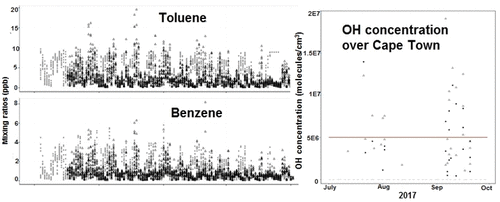当前位置:
X-MOL 学术
›
ACS Earth Space Chem.
›
论文详情
Our official English website, www.x-mol.net, welcomes your feedback! (Note: you will need to create a separate account there.)
Atmospheric Toluene and Benzene Mole Fractions at Cape Town and Cape Point and an Estimation of the Hydroxyl Radical Concentrations in the Air above the Cape Peninsula, South Africa
ACS Earth and Space Chemistry ( IF 3.4 ) Pub Date : 2019-12-13 , DOI: 10.1021/acsearthspacechem.9b00207 Brett Kuyper 1 , Haithum Wingrove 2 , Timothy Lesch 1 , Casper Labuschagne 3 , Daniel Say 4 , Damien Martin 4 , Dickon Young 4 , M. Anwar H. Khan 4 , Simon O’Doherty 4 , Michael T. Davies-Coleman 1 , Dudley E. Shallcross 1, 4
ACS Earth and Space Chemistry ( IF 3.4 ) Pub Date : 2019-12-13 , DOI: 10.1021/acsearthspacechem.9b00207 Brett Kuyper 1 , Haithum Wingrove 2 , Timothy Lesch 1 , Casper Labuschagne 3 , Daniel Say 4 , Damien Martin 4 , Dickon Young 4 , M. Anwar H. Khan 4 , Simon O’Doherty 4 , Michael T. Davies-Coleman 1 , Dudley E. Shallcross 1, 4
Affiliation

|
Benzene and toluene, emitted into the atmosphere from a number of common anthropogenic activities, pose a significant human health risk. The mole fractions of toluene and benzene were measured at two urban locations (Foreshore and Potsdam) in Cape Town and one background site at Cape Point, South Africa over the period of July–November 2017. The analysis of the mole fractions of benzene and toluene at two sampling sites in the city of Cape Town gave an indication of the probable anthropogenic sources of the air masses sampled at these sites. We propose that a traffic source dominated at the Foreshore site, while industrial processes dominated at the Potsdam site. The analysis of wind rose plots of benzene and toluene and the elevated mole fractions observed at the remote “clean air” sampling site, Cape Point, suggest that polluted air from Cape Town is the major source of the benzene and toluene mole fractions observed at Cape Point. Hydroxyl (OH) radical concentrations were estimated for Cape Town from the difference in T/B ([toluene]/[benzene]) ratios between Cape Town and Cape Point. The Cape Town OH estimations displayed a mean of (7.2 ± 3.5) × 106 molecules cm–3 at the Foreshore site and (9.1 ± 4.4) × 106 molecules cm–3 at the Potsdam site, without consideration of dilution reducing to (5.4 ± 3.4) × 106 molecules cm–3 for the Foreshore site and (7.4 ± 4.6) × 106 molecules cm–3 for the Potsdam site for the period of July–November 2017 when dilution was considered. The estimated Cape Town OH concentrations are on the high side but consistent with the results from other urban studies and may suggest a role for OH recycling following biogenic emissions between Cape Town and Cape Point.
中文翻译:

南非开普敦和开普角的大气甲苯和苯摩尔分数及南非空气中羟自由基浓度的估算
许多常见的人为活动释放到大气中的苯和甲苯构成了重大的人类健康风险。在2017年7月至11月期间,在南非开普敦的两个城市地点(沿海和波茨坦)和南非开普角的一个背景地点测量了甲苯和苯的摩尔分数。分析了苯和甲苯的摩尔分数在开普敦市的两个采样点,给出了在这些采样点采样到的可能的人为气源的迹象。我们建议在前岸站点占主导地位的交通来源,而在波茨坦站点占主导地位的工业流程。分析了在遥远的“清洁空气”采样点开普角(Cape Point)观测到的苯和甲苯的风玫瑰图和升高的摩尔分数,这表明来自开普敦的污染空气是在开普角观察到的苯和甲苯摩尔分数的主要来源。根据开普敦和开普角之间的T / B([甲苯] / [苯])比之差,估算开普敦的羟基(OH)自由基浓度。开普敦的OH估计值显示为(7.2±3.5)×106分子厘米-3在滨位点和(9.1±4.4)×10 6分子厘米-3在波茨坦部位,而不考虑稀释的减少(5.4±3.4)×10 6分子厘米-3的滨位点和(7.4±4.6)×10 6个分子cm –3(考虑稀释),适用于2017年7月至11月的波茨坦站点。开普敦的OH估计浓度偏高,但与其他城市研究的结果一致,并且可能表明开普敦和开普角之间的生物排放后OH的循环利用。
更新日期:2019-12-17
中文翻译:

南非开普敦和开普角的大气甲苯和苯摩尔分数及南非空气中羟自由基浓度的估算
许多常见的人为活动释放到大气中的苯和甲苯构成了重大的人类健康风险。在2017年7月至11月期间,在南非开普敦的两个城市地点(沿海和波茨坦)和南非开普角的一个背景地点测量了甲苯和苯的摩尔分数。分析了苯和甲苯的摩尔分数在开普敦市的两个采样点,给出了在这些采样点采样到的可能的人为气源的迹象。我们建议在前岸站点占主导地位的交通来源,而在波茨坦站点占主导地位的工业流程。分析了在遥远的“清洁空气”采样点开普角(Cape Point)观测到的苯和甲苯的风玫瑰图和升高的摩尔分数,这表明来自开普敦的污染空气是在开普角观察到的苯和甲苯摩尔分数的主要来源。根据开普敦和开普角之间的T / B([甲苯] / [苯])比之差,估算开普敦的羟基(OH)自由基浓度。开普敦的OH估计值显示为(7.2±3.5)×106分子厘米-3在滨位点和(9.1±4.4)×10 6分子厘米-3在波茨坦部位,而不考虑稀释的减少(5.4±3.4)×10 6分子厘米-3的滨位点和(7.4±4.6)×10 6个分子cm –3(考虑稀释),适用于2017年7月至11月的波茨坦站点。开普敦的OH估计浓度偏高,但与其他城市研究的结果一致,并且可能表明开普敦和开普角之间的生物排放后OH的循环利用。


























 京公网安备 11010802027423号
京公网安备 11010802027423号